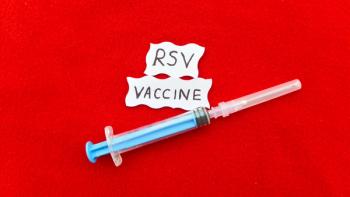
Anti-PD-1 Monoclonal Antibody With Standard of Care Improves Outcomes for BCG-Naïve Bladder Cancer
Key Takeaways
- Sasanlimab combined with BCG significantly improved event-free survival in high-risk NMIBC patients, reducing recurrence or progression risk by 32%.
- The CREST trial highlighted sasanlimab's potential to redefine treatment paradigms for BCG-naïve, high-risk NMIBC.
A study reveals sasanlimab enhances event-free survival in high-risk bladder cancer patients, offering new hope against disease recurrence.
Sasanlimab (Pfizer), an investigational anti-PD-1 monoclonal antibody (mAB), used in combination with standard of care (SOC) Bacillus Calmette-Guérin (BCG) as induction therapy with or without maintenance in patients with BCG-naïve, high-risk non-muscle invasive bladder cancer (NMIBC), has achieved its primary end point, according to research published by investigators at Pfizer. The results were found in a pivotal phase 3, multinational, randomized, open-label, 3 parallel-arm CREST study (NCT04165317) that assessed sasanlimab with or without BCG maintenance compared with BCG induction and maintenance in individuals with BCG-naïve, high-risk NMIBC.1
“New bladder cancer treatment options that help reduce rates of disease recurrence or progression are long overdue. Up to 50% of patients with high-risk NMIBC may experience failure of BCG intravesical immunotherapy, yet it has been the standard of care after tumor resection for decades,” Neal Shore, MD, FACS, medical director for START Carolina Research Center, and lead investigator for the CREST trial, said in a news release.1
Bladder cancer is responsible for nearly 220,000 deaths annually, with NMIBC representing 75% of all bladder cancer cases; however, 38,000 individuals are reported to have high-risk NMIBC in the US.1 This cancer typically begins in the urothelial cells that line the inside of the bladder and is diagnosed in the early stage for most individuals, making it highly treatable.2 Previous research has demonstrated a reduction of tumor recurrence by 40% to 50% in those with high-risk NMIBC treated with BCG, but bladder cancer can still come back even with successful treatment.1
“Today’s pivotal Phase 3 CREST results offer a much-needed therapeutic breakthrough and spotlight sasanlimab as the first immunotherapy combination with BCG to significantly improve outcomes for patients with BCG-naïve, high-risk NMIBC in over 3 decades,” said Megan O’Meara, MD, interim chief development officer at Pfizer Oncology, in a news release.1
As a humanized immunoglobulin (G4) (IgG4) mAb, sasanlimab binds to the human PD-1 to block its interaction with OD-1, PD-L1, and PD-L2. The drug can be administered through a 2 mL subcutaneous (SC) injection prefilled syringe once every 4 weeks, according to the study authors.1
In the CREST trial, individuals were randomly assigned to receive a 300-mg dose of sasanlimab via SC injection every 4 weeks up to cycle 25, in combination with BCG once weekly for 6 consecutive weeks (arm A; n = 352), followed or not by maintenance with BCG (arm B; n = 352), or BCG induction and maintenance with BCG, or BCG induction and maintenance up to cycle 25 (arm C; n = 351).1
The results demonstrated that adding sasanlimab to the standard BCG treatment significantly improved how long patients with high-risk, NMIBC lived without disease-related events (hazard ratio [HR]: 0.68; 95% confidence interval [CI], 0.49-0.94; 2-sided P = .019), meeting the study’s primary end point of event-free survival (EFS). Specifically, the combination reduced the risk of high-grade recurrence or progression by approximately 32% compared to BCG alone. The study authors noted that this benefit was also seen in subgroups of patients with higher-risk disease, such as those with T1 and carcinoma in situ (CIS) disease.1
“These phase 3 results show that combining sasanlimab with BCG induction and maintenance therapy earlier in the course of the disease significantly prolonged EFS, highlighting the value and potential of sasanlimab in combination with BCG to redefine the treatment paradigm and reduce the burden for patients,” Shore said in a news release.1
An early look at overall survival data did not show a difference between the treatment group, and follow-up is ongoing for the final analysis; however, in individuals with CIS, the combination of sasanlimab and BCG resulted in a slightly higher complete response rate compared with BCG alone. Importantly, individuals with CIS who achieved a complete response were significantly more likely to maintain that response at 36 months with the sasanlimab combination than with BCG alone.1
Additionally, the safety profile of the combination was consistent with previous safety profiles, along with the reported safety profile of PD-1 inhibitors.1
“The CREST findings are especially impactful for these patients with early-stage cancer who may benefit the most from innovative treatment regimens, including a subcutaneous immune checkpoint inhibitor, that delay disease recurrence or progression,” O’Meara said in a news release.1
REFERENCES
1. Pfizer’s Sasanlimab Combination Significantly Improves Event-Free Survival in BCG-Naïve, High-Risk Non-Muscle Invasive Bladder Cancer. Pfizer. News release. April 26, 2025. Accessed May 19, 2025. https://www.pfizer.com/news/press-release/press-release-detail/pfizers-sasanlimab-combination-significantly-improves-event
2. Bladder Cancer. Mayo Clinic. News release. March 29, 2024. Accessed May 19, 2025. https://www.mayoclinic.org/diseases-conditions/bladder-cancer/symptoms-causes/syc-20356104
Newsletter
Stay informed on drug updates, treatment guidelines, and pharmacy practice trends—subscribe to Pharmacy Times for weekly clinical insights.




















































































































































































































